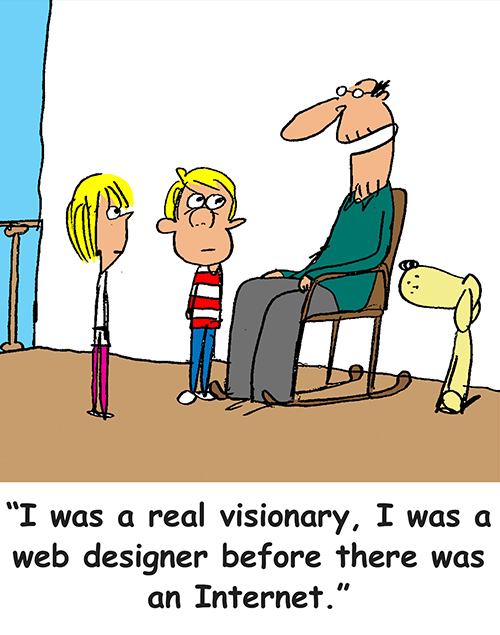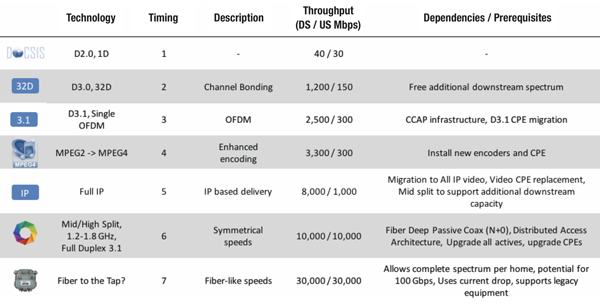SOS… Getting Help with the “Shiny Object Syndrome”
By Jeff Finkelstein
Cable technologies move fast, in many cases faster than other parallel service provider industries. From the start of cable technology deployments, we have seen incredible transformations in how we deliver services to our customers. Beginning with the days of forward only outside plant to bidirectional, 20+ amp cascades to passive coax, analog to digital carriers, proprietary data services to standardized DOCSIS, QPSK to QAM to OFDM. Sometimes it feels like we are just starting to act upon deploying the latest, greatest, neatest, cheapest, fastest technologies, then…
We read a new article or press release about the next generation of geeky cool stuff that outperforms what we are only starting to design for deployment today. And of course, this tends to happen right in the middle of our budget cycle.
This means we get calls from our senior technology execs wanting to know about it, senior product execs wanting to know when we will be deploying it, and senior financial execs wanting to know how much of our budgets they can cut since the new technology being discussed is going to be cheaper than what we are planning on deploying today.
After months of research, analysis, planning and budgeting, we get one step away from the finish line only to realize we have to go back to the starting gate and begin all over. Wash, rinse, repeat…
Sound familiar? I expect for many it does…
While all this is occurring parenthetically to our engineering of solutions improving reliability, providing more bandwidth and throughput, and solving current customer problems and desires, the ripple effect caused by these announcements forces us to reevaluate our strategy. The result is what many call “analysis paralysis.”
This has become the leitmotif of many budget planning cycles. The excitement of the latest press announcement for new potential technologies takes away the enthusiasm from currently available equipment we are using to build our next generation networks. No more wind in the sails causes the ship to stall.
You do not need to look any further than CES, CableLabs conferences, Mobile World Congress or SCTE/ISBE Cable-Tec Expo. The crowds around the cool new technologies are larger than those looking at the previous generation of gear. The excitement of the unknown is greater than the previous generation of technology.
This is what I call SOS, the “shiny object syndrome.” We all have the human tendency to want the latest technology to reduce our operational and capital expenditures, along with simplifying the deployment models. But, what does this mean to the original plans we made?
I am a living example of SOS. I have had every iPhone and iPad made since they came out. Even though my current phone and tablet are working fine, I still get the latest technology. There is something about the latest tech available that draws us in like moths to a light.
Many of the futuristic technologies are initially made of that rarest of metals called “unobtanium.” They look great on PowerPoint slides, sound wonderful when the advocates pitch them and the graphs shown look incredible. How could we not be drawn into the web of possibilities that they will make available to us?
We seem to get caught up in the enthusiasm and forget that there are often missing pieces to this puzzle. I have never seen a new technology fail on a PowerPoint slide. As the futurist and writer Arthur C. Clarke once famously said, “Any sufficiently advanced technology is indistinguishable from magic.” And who does not like magic?
Many of these new technologies are based on the previous generations, often the very ones we were planning to deploy when we got caught up in the excitement. These future technologies promise new capabilities for the cable network that even a few months ago we never dreamt as possible, but to become operationally ready they need time to mature and transform into actual deployable technologies.
For those of us that have been in cable for many years, we have seen this time and again. Personally, I have been involved at some level since the beginning of DOCSIS. It seems we are just finishing the current spec while beginning to discuss what is coming next. As a real example, while we were beginning to deploy DOCSIS 3.0 I began talking about gigabit data services over the cable plant in 2007 with CableLabs and what it would mean if we replaced legacy quadrature amplitude modulation (QAM) with something different. These discussions led to the develop of DOCSIS 3.1, a radical improvement over earlier forms of data transmission over cable. Now almost 10 years later many are beginning to deploy this new system of DOCSIS as the default technology.
And even as we are now finalizing our plans as an industry to deploy DOCSIS 3.1, we are working on specifications for what we are calling full duplex DOCSIS (FDX). What FDX enables is a method to increase our available upstream bandwidth while still being backwards compatible with our current DOCSIS technologies. There have been many articles written and presentations given about what this technology will be capable of providing, but we often lose sight of the realities of what it takes to get there.
The cable system is a seemingly singular series of intricate technologies we fit together like a puzzle, each complex in its own way, which when united create an ecosystem with great potential for new and improved service delivery and future growth. The new technologies being considered for use build on the previous generations to create something new and unique. As a futurist and engineer, I need to make sure that the foundation we base these new technologies on is solid as possible, for without it the new capabilities will not work as planned or expected.

“Let’s Multi-Year Strategize”
Without a destination in mind, every step takes you in the right, and wrong, direction at the same time. Having a multi-year vision is critical to defining what I call the “no regret” decisions. It is the Schrödinger’s Cat scenario of technology advancement. Every movement forward in technology is both right and wrong simultaneously. Yet, we must keep feeding our networks because they are living, breathing entities, which need new technologies to satisfy the ever-increasing demand for bandwidth to meet customer needs, better reliability and reduced truck rolls to improve customer satisfaction, and make better use of our ever-decreasing available capital. These are the constraints we are all working under in these challenging times.
I like comparing this paradox to a GPS application where we must first set the destination. The GPS app calculates the path we will take and begins giving the direction to go in order to end up at the desired end point. The basic GPS apps have the ability to create the entire route and provide the next turn to get us moving in the correct direction. The more intelligent GPS apps not only provide directional guidance, but also remain aware of changes in the traffic patterns ahead, such that if they determine when a change needed in a future route is required to optimize our path, they will bring it to our attention as we get closer to that point in travel.
The “no regret” part of the guidance are things that we see closer to us and will have minimal impact on the future if they are executed correctly. If something has occurred in the predetermined route that forces us to change our path, the GPS will kindly “recalculate” the remainder of the path. They are prescient based on inputs of which we are not aware, but they are not all knowing or all seeing. There is room to improve on future guidance based on past experiences. The development of a multi-year strategy needs to be flexible, but must clearly lay out the short-term choices and decisions that we will not regret at a later time.
I believe some “no regret” choices are easier to see. For example, as you do plant maintenance or installs, replacing the tap face plate with a 1.2 GHz capable one makes sense. You may not know at this time that you will do 1.2 GHz, but the added cost delta from a 1 GHz to a 1.2 GHz tap is not something you will regret. Cleaning up or replacing connectors, installing new high quality drop cables sometimes with a single fiber embedded in the cable to enable future FTTH services or installing fiber along with new trunk or drop cables, and other physical improvements to the outside plant are rarely regretted. More esoteric improvements like replacing modules in fiber nodes or amplifiers need qualification from other strategic decisions, e.g., are you considering a mid- or high-split, will you be deploying a top end of 1.2 GHz or 1.8 GHz, or will you be reducing your amplifier cascade, should be considered. In the end, each operator will have some common and unique “no regret” decisions to make.
When considering a multi-year strategy, define the destination first. Where are you trying to go? What is the time frame? What services will be likely and possible that you must account for? What new product revenue streams are to be considered? And so on…
Very few technologies exist in a vacuum. As you define the steps needed to reach your goal, think about the technologies that you could or would use in each step. How can you leverage those at each step to create new opportunities, cost reductions or reduce complexity of future technologies? The opportunity to define the vision and direction is now.
You do not need to have every step laid out in perfect timelines. That will come later. The goal of this exercise is to define the stages that you can use to fill in the gaps with financial considerations of cost to deploy, savings realized and product enablement to drive new revenue.
The accompanying table shows an example I like to use when describing a high-level multi-year strategy.
A few things to point out in the table is that there are no specific dates, no financials and no vendor information. The goal is to show what the technologies are, what is the sequence of execution, a description of the results, the throughput enabled by the technology, and most importantly what are the dependencies needed to enable the technology at each stage.
I firmly believe that the cable network not only has a long life, but it has a long useful life. To make that future a reality we must think long-term, but act short-term. A strategic approach to deploying cable technologies is essential to help us determine the “no regret” decisions and act upon them. This way even when new cool technologies pop-up we can continue to execute our short-term plans to give us time to analyze what the latest shiny objects mean to our strategy.
My favorite saying is one we use at Cox. “Act Now. Be Bold. Stay True.”
For this column, I will leave it here as food for thought. Future columns will get into more details around the thought process of coming up with setting and pitching a multi-year strategy.
If you would like to discuss any of these thoughts or chat about future thinking feel free to email me at jeff.finkelstein@cox.com.

 Jeff Finkelstein
Jeff Finkelstein
Executive Director of Advanced Technology
Cox Communications
Jeff Finkelstein is the Executive Director of Advanced Technology at Cox Communications in Atlanta, Georgia. He has been a key contributor to the engineering organization at Cox since 2002, and led the team responsible for the deployment of DOCSIS® technologies, from DOCSIS 1.0 to DOCSIS 3.0. He was the initial innovator of advanced technologies including Proactive Network Maintenance, Active Queue Management and DOCSIS 3.1. His current responsibilities include defining the future cable network vision and teaching innovation at Cox.
Jeff has over 43 patents issued or pending. His hobbies include Irish Traditional Music and stand-up comedy.
Credit: Cartoonstock.com
Credit: Shutterstock
Credit: Chart Provided by Author




